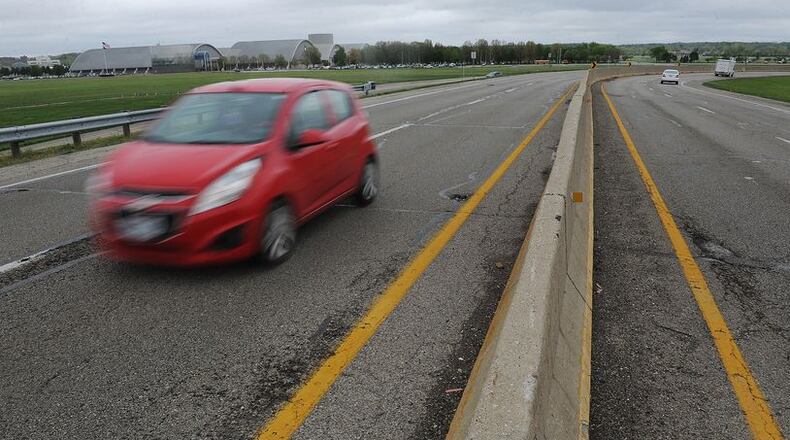Some residents have said they strongly oppose new roundabouts on the road, arguing there must be other infrastructure improvements or changes that can be made to achieve the city’s safety goals.
Woodman Drive (which becomes Harshman Road further north) is an arterial road that runs north to south and goes by the National Museum of the U.S. Air Force, the fencing around the Wright-Patterson Air Force Base, homes, apartments, parks, schools and offices, including those housing city administration.
Riverside City Manager Josh Rauch said motorists regularly drive off the roadway and get into crashes, including at bends in the road. He said the road has potholes, a concrete median wall and curves that cause problems for motorists, and also some people walk or bike along the shoulder, which is very unsafe.
The city expects to soon share information from a draft action plan that contains proposals for safety improvements along the corridor. Riverside developed the action plan after receiving a $700,000 federal Safe Streets and Roads for All (SS4A) grant a few years ago, which required a $140,000 local match.
The action plan, or concept study, offers ideas for safety improvements on Woodman Drive (Harshman Road), roughly between Springfield Street and U.S. 35, like lowering or flattening an elevated section of the corridor, installing curbs and creating narrower lanes, according to Rauch. One rendering shows a grassy median and tree lawns.
“It looks, acts and feels like a highway today,” Rauch said. “The concept that we have in front of us is to turn it much more into a boulevard feel with a slower pace of travel.”
The plan also explores possibly installing roundabouts at a few intersections like the Springfield Street bridge.
The bridge is expected to have major maintenance needs in coming years. Rauch said the infrastructure on Woodman is failing and needs to be replaced, but the layout of the road contributes to safety problems.
Rauch said engineers believe roundabouts tend to be safer, reduce traffic speeds and are less expensive to maintain than traditional intersections that have traffic lights.
Studies by the Federal Highway Administration indicate that when roundabouts replace a traffic signal, the intersections see a 48% reduction in crashes and nearly 80% drop in serious injury and deadly crashes, says the Ohio Department of Transportation.
The action plan contains conceptual renderings of what a roundabout and a traditional intersection would look like at Woodman and Springfield roads.
“All of this engineering and study has been done to try to identify the ground-level things we need to do to make the roadway safer,” Rauch said. “But there are no commitments here, and it really is a document that talks about the process that we went through to arrive at some of these things and the engineering principles behind them.”
Riverside also received a $1.5 million Congressional earmark that the city plans to use to pay for a feasibility study and design work for Woodman Drive. The funding will help evaluate some of the proposed safety improvements.
The study could take 18 months or more to complete, and the city is providing a $375,000 local match, officials said.
In addition, Riverside last month applied for a $1.5 million grant through the state’s Transportation Review Advisory Council (TRAC).
If Riverside’s application is approved, the city expects to use the TRAC dollars to pay for detailed designs for improvements to Woodman Drive that were identified through the feasibility study and design process, Rauch said.
The city expects to find out this fall if it has been awarded TRAC funding, which would require a $400,000 local match.
Safety improvement projects to Woodman Drive likely would have to occur in phases, and the city would have to obtain funding for the construction costs. Officials have stressed that there are no firm plans in place.
Freda Patterson, a Riverside resident, last month said she’s concerned about the potential for multiple roundabouts on Woodman/Harshman.
She said they make sense in more rural areas, but suggested they are dangerous in high traffic areas. She said there must be cheaper alternatives that are effective at reducing speeding and traffic problems and added she felt “blindsided” to learn that Riverside was exploring concept proposals for roundabouts.
Christiana Couch, a local resident, said the main issue is speeding on Woodman. She said she believes lowering the speed limit would be the best safety strategy, or maybe installing a new traffic light. She opposes putting in roundabouts.
About the Author




